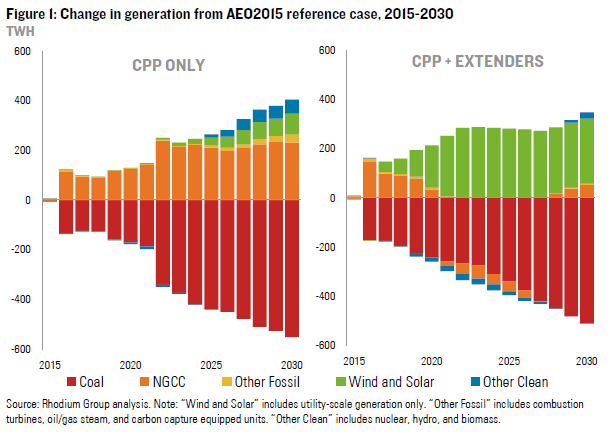Renewable energy is the lowest-cost Clean Power Plan compliance solution, finds new analysis
Renewable energy accounts for virtually all of the new generation additions in the lowest-cost solution for complying with Environmental Protection Agency’s (EPA) Clean Power Plan (CPP), according to new economic modeling using a Department of Energy tool.
The analysis predicts that states and utilities will move quickly over the next few years to use renewable energy to lock in most of the CPP’s required reductions in carbon pollution, taking advantage of record low costs for wind and solar energy and tax credits that were recently extended, as shown on the right side of the chart below.
In its research note, the Rhodium Group explains that the extensions of wind and solar tax credits at the end of last year “change the game for CPP compliance.” As a result, wind and solar are “the technolog(ies) of choice for the entire CPP compliance period.” The chart above shows that the tax credit extension shifts the lowest-cost compliance option from natural gas combined cycle (NGCC) generation (on the left) to wind and solar (on the right). As the Rhodium Group notes, “The tax extenders allow states to meet pending carbon dioxide regulations almost exclusively with zero-emitting renewables.”
States and utilities must act quickly to take advantage of the record low wind energy prices that are available while the tax credits are in effect. Wind projects must start construction by the end of this year to qualify for the full value of the renewable production tax credit. The tax credit drops to 80 percent of its full value for projects that begin in 2017, 60 percent in 2018, and 40 percent in 2019.
Recent cost reductions driven by technological advances have made wind energy the lowest-cost energy source for reducing carbon pollution. Data compiled by the Lawrence Berkeley National Laboratory (LBNL) shows that the market price utilities pay to purchase wind energy has fallen by two-thirds since 2009. Wall Street investment firm Lazard, Inc. also shows a cost decline of more than 60 percent, and notes that wind energy is by far the lowest-cost energy source for reducing emissions, even without tax incentives.
Lazard also finds the cost of using wind energy to reduce carbon pollution is negative. In other words, it makes sense for utilities to buy wind just to save their customers money. Wind’s environmental benefits, which can be used to reduce the cost of CPP compliance, are an added bonus. This is reflected in a number of recent quotes from utilities and state utility commissions describing the large consumer savings they are seeing from buying wind energy.
The primary advances in wind turbine technology that have driven cost reductions are larger turbine blades and taller towers. These methods capture more wind energy and access higher wind speeds farther above the earth’s surface.
This has been particularly beneficial in parts of the U.S. that were traditionally thought to lack strong wind resources, because wind speeds closer to the earth’s surface were lower. For example, the first large wind project in North Carolina is now under construction, thanks to advances in blade technology that the project developer called a “game changer.” The Rhodium Group’s analysis looked at the lowest-cost CPP compliance mix in all regions, and its strong results indicate renewable energy was the most attractive CPP solution across the country.
The Rhodium Group’s results confirm the finding of last year’s report by the Energy Information Administration (EIA), which also found wind accounted for the majority of the lowest-cost compliance solution for the proposed CPP. That report showed wind playing a key compliance role in nearly all regions, and also found wind to be a no-regrets compliance option that provided significant savings in all scenarios, even one with low natural gas prices.
Both analyses are likely conservative estimates of the benefits of using wind energy for CPP compliance because they rely on an EIA estimate for the cost of wind energy that is about 20 percent higher than real-world costs, as observed in data collected by LBNL. While the Rhodium Group did not release the breakdown between wind and solar deployment in its analysis, it almost certainly found a much larger role for wind energy since it is based on EIA assumptions that put solar costs more than 50 percent higher than wind costs.
Part of the reason these reports find such a large role for zero-emission wind and solar energy is that those resources provide a larger “bang for the buck” for CPP compliance relative to resources with some emissions. For example, because one megawatt-hour (MWh) of gas generation emits nearly half as much CO2 as one MWh of coal generation, nearly twice as many MWh of coal generation must be displaced by gas to achieve the same level of emissions reductions that would be provided by wind. As a result, wind energy provides compliance flexibility while reducing the magnitude of change that is required to the existing generation mix, allowing for more cost-effective compliance solutions, including the continued use of existing coal capacity.
One major renewable energy benefit that is not accounted for in these reports is fuel price stability. Renewable resources have no fuel cost, so utility purchasers can lock in a contract price for a period of 20 years or more, something that is not possible with fossil fuels. EIA’s analysis found that relying heavily on natural gas for CPP compliance caused natural gas prices to spike by around $1, increasing energy costs for all consumers, while gas prices fell below what they had been once renewable energy use ramped up. The Department of Energy’s Wind Vision report confirms this, finding electric prices are 20 percent less sensitive to changes in natural gas prices in scenarios with large amounts of wind energy.






